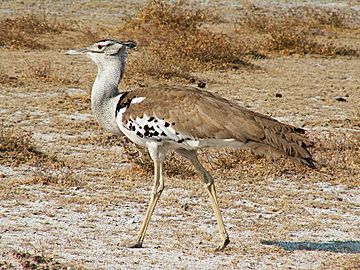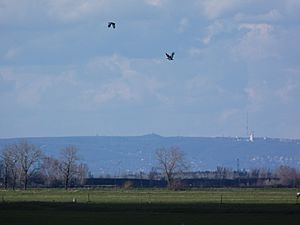Bustard facts for kids
Quick facts for kids Bustards |
|
|---|---|
 |
|
| Kori bustard (Ardeotis kori) | |
| Scientific classification |
|
| Kingdom: | Animalia |
| Phylum: | Chordata |
| Class: | Aves |
| Clade: | Otidimorphae |
| Order: | Otidiformes Wagler, 1830 |
| Family: | Otididae Rafinesque, 1815 |
| Genera | |
|
|
| Synonyms | |
|
|
Bustards are large birds that live mostly on the ground. They include birds like floricans and korhaans. You can find them in dry grasslands and open plains in places like Africa, Europe, and Asia. These birds can be anywhere from about 40 cm (16 inches) to 150 cm (59 inches) long. They belong to the bird family called Otididae.
Bustards eat many different things. They are omnivores, meaning they eat both plants and animals. Their diet includes leaves, buds, seeds, fruits, and small animals like insects and tiny vertebrates. There are 26 different kinds of bustard species known today.
Contents
What Bustards Look Like
Bustards are quite big birds. The two largest types are the kori bustard and the great bustard. These are often called the heaviest flying birds in the world! Big male bustards of these species can weigh over 20 kg (44 lb). On average, they weigh about 13.5 kg (30 lb) and can be up to 150 cm (59 inches) long.
The smallest bustard is the little brown bustard. It is about 40 cm (16 inches) long and weighs around 600 g (1.3 lb).
In most bustard species, the males are much bigger than the females. Males can be about 30% longer and sometimes more than twice as heavy! This big difference between males and females is called sexual dimorphism. However, in floricans, it's the opposite: the adult female is a bit bigger and heavier than the male.
Bustards have 10 main flight feathers on their wings and 16 to 24 secondary feathers. Their tails usually have 18 to 20 feathers. Their feathers often have patterns that help them blend in with their surroundings. This is called cryptic plumage.
How Bustards Behave
Bustards are omnivores. They mostly eat seeds and small creatures without backbones, like insects. They build their nests on the ground. This means their eggs and young birds can be easily found by predators.
They walk steadily on their strong legs and big toes, looking for food as they go. Most bustards prefer to run or walk away from danger rather than fly. When they do fly, they have long, wide wings with "fingered" tips and cool patterns.
Many male bustards have interesting ways to attract a mate. They might inflate special throat sacs or lift up fancy feathered crests. After mating, the female lays three to five dark, speckled eggs in a shallow dip in the ground. She then sits on the eggs by herself until they hatch.
Where Bustards Came From
Scientists have studied the genes of bustards. They believe that bustards first appeared about 30 million years ago. This happened in either southern or eastern Africa. From there, they spread out to Europe, Asia, and Australia.
Bustard Family Tree
The family name for bustards, Otididae, was first used in 1815 by a French scientist named Constantine Samuel Rafinesque. This family includes many different types of bustards, like the Kori bustard and the Great bustard.
Protecting Bustards
Outside of the breeding season, bustards often live in groups. They are very careful and hard to get close to in the open areas where they live.
Sadly, most bustard species are decreasing in numbers or are endangered. This is mainly because their homes are being destroyed and because of hunting. Even in places where they are supposed to be protected, they are still at risk.
Bustards in the United Kingdom
Bustards used to be common in Britain, especially on Salisbury Plain. But by 1819, they were very rare. The last bustard in Britain died around 1832.
However, there's good news! People are now bringing bustard chicks from Russia to reintroduce them to Britain. In 2009, two great bustard chicks were born in Britain for the first time in over 170 years! More reintroduced bustards also hatched chicks in 2010, helping to bring them back.
What are Floricans?
Some bustards found in India are also called Floricans. The exact reason for this name is not completely clear. A long time ago, in 1862, a writer named Thomas C. Jerdon wondered about it in his book The Birds of India.
I have not been able to trace the origin of the Anglo-Indian word Florikin, but was once informed that the Little Bustard in Europe was sometimes called Flanderkin. Latham gives the word Flercher as an English name, and this, apparently, has the same origin as Florikin.
– Jerdon's Birds of India, 2nd ed. ii. 625.
However, another old dictionary, called Hobson-Jobson, suggests a different idea. They think that "Flercher" might have been a mistake for a word similar to "floriken."
See also
 In Spanish: Otídidos para niños
In Spanish: Otídidos para niños


